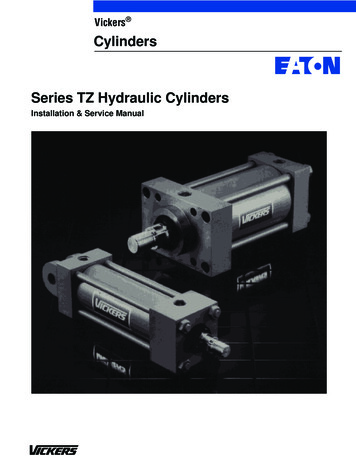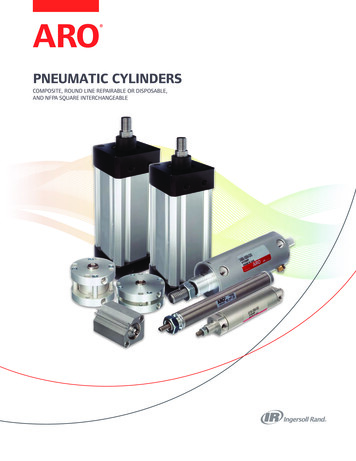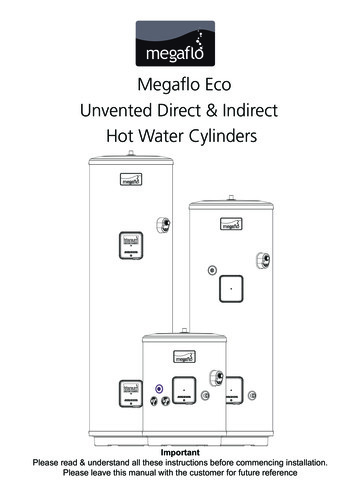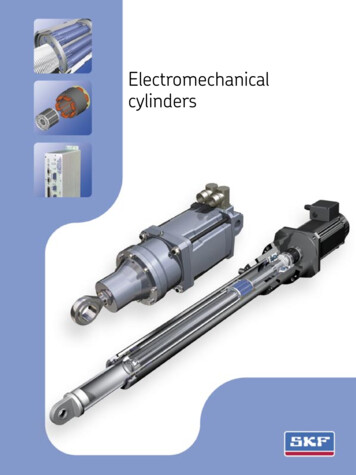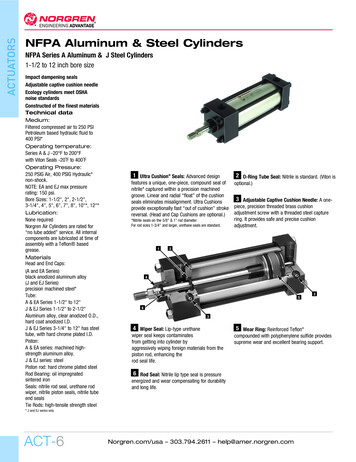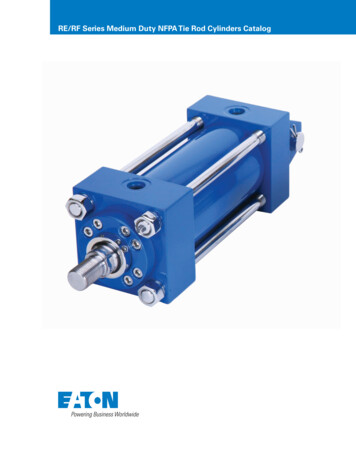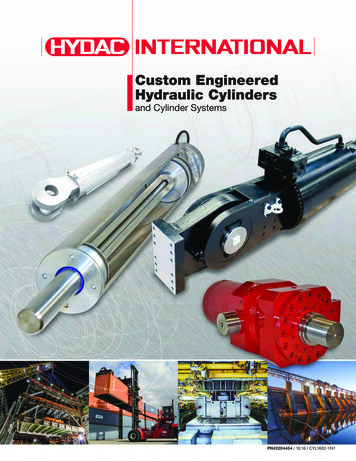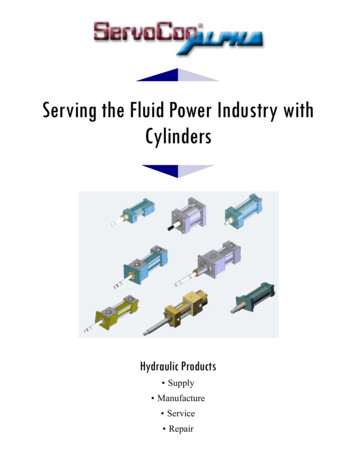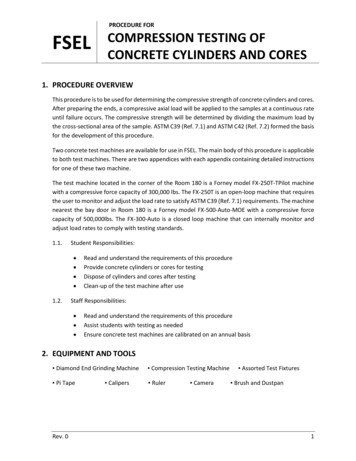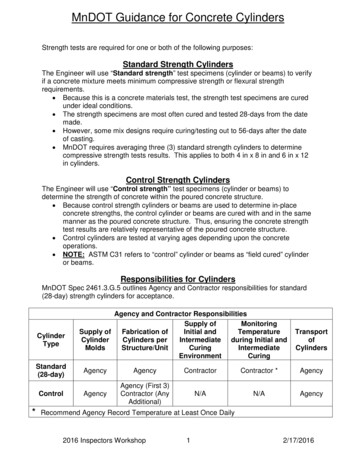
Transcription
MnDOT Guidance for Concrete CylindersStrength tests are required for one or both of the following purposes:Standard Strength CylindersThe Engineer will use “Standard strength” test specimens (cylinder or beams) to verifyif a concrete mixture meets minimum compressive strength or flexural strengthrequirements. Because this is a concrete materials test, the strength test specimens are curedunder ideal conditions. The strength specimens are most often cured and tested 28-days from the datemade. However, some mix designs require curing/testing out to 56-days after the dateof casting. MnDOT requires averaging three (3) standard strength cylinders to determinecompressive strength tests results. This applies to both 4 in x 8 in and 6 in x 12in cylinders.Control Strength CylindersThe Engineer will use “Control strength” test specimens (cylinder or beams) todetermine the strength of concrete within the poured concrete structure. Because control strength cylinders or beams are used to determine in-placeconcrete strengths, the control cylinder or beams are cured with and in the samemanner as the poured concrete structure. Thus, ensuring the concrete strengthtest results are relatively representative of the poured concrete structure. Control cylinders are tested at varying ages depending upon the concreteoperations. NOTE: ASTM C31 refers to “control” cylinder or beams as “field cured” cylinderor beams.Responsibilities for CylindersMnDOT Spec 2461.3.G.5 outlines Agency and Contractor responsibilities for standard(28-day) strength cylinders for ncy and Contractor ResponsibilitiesSupply ofMonitoringSupply ofFabrication ofInitial andTemperatureCylinderCylinders perIntermediate during Initial ontractor *AgencyAgencyAgency (First 3)Contractor (AnyAdditional)N/AN/AAgencyRecommend Agency Record Temperature at Least Once Daily2016 Inspectors Workshop12/17/2016
MnDOT Guidance for Concrete CylindersCasting CylindersFollow ASTM C31, Section 9. Molded Specimens, for casting concrete cylinders foruniform and comparable results.When making the test specimens: Place molds on a level, firm foundation in a sheltered place where they canremain undisturbed and protected from direct sunlight and maintained attemperatures of 60 - 80 F [16 - 27 C] for the initial 16-48 hours. The supporting surface on which specimens are stored shall be level to within ¼in. per ft. If specimens cannot be molded at the place where they will receive initial curing,immediately after finishing move the specimens to an initial curing place forstorage. If temperatures are outside the range of 60 - 80 F, or a casting site is notavailable in the immediate proximity of the work, transport the sampled concreteto a casting location where the specimens will remain at 60 - 80 F undisturbedfor the initial 16-48-hour period. Re-mix by hand shoveling prior to casting thetest cylinder.Cylinder Mold Requirements White is MnDOT’s standard color for concrete cylinder molds & cylinder moldcovers.MnDOT Concrete Engineer requires use of flat cylinder mold covers.All three 4’’ by 8’’ standard strength test cylinders are all made from the sameconcrete sample. The same applies to sets of 6 in x 12 in cylinders.Cylinder Size4 in x 8 in* 6 in x 12 inMaximumAggregateSize 1.25 inch 1.25’ inch Standard StrengthCylindersControl CylindersSets of 3Sets of 311*6’’ by 12’’ cylinder molds required when nominal aggregate size exceeds 1 ¼”. Refer to Schedule of Materials Control for Number of Sets Required2016 Inspectors Workshop22/17/2016
MnDOT Guidance for Concrete CylindersNumbering Sets of Cylinders ID sets of cylinders sequentially, 1.1 – 1.2 – 1.3, 2.1 – 2.2 – 2.3 etc. Prefixes and suffixes are allowed, i.e. BR 1.1 – 1.2 – 1.3 Keep the same whole numbers for control cylinders and continueincreasing numbers after the decimal. For example, an additional two control cylinders were made whencasting the standard strength cylinders (2.1-2.2-2.3), the controlcylinders would then continue the numbered as 2.4 and 2.5. Control Cylinders require separate ID cards for each cylinder. Control strength cylinders are not averaged.Curing and Handling Standard (28-day) Strength CylindersFor concrete to develop its full strength potential, ensure the standard strength testspecimens are stored in a moist condition within specified temperature range andtransported with care.Moisture loss is detrimental to the concrete strength. Prevent/control moistureloss by: Placing the specimen in an insulated box/coolers containing moisture Covering with polyethylene sheeting or bags Covering with a minimum of 4 thicknesses of wet burlap Covering with waterproof paper Placing caps on plastic cylinder molds NOTE: Do not allow standard strength cylinder or beams to dry to awhitened state.Transport strength test specimens with tightly affixed cylinder mold covers to preventmoisture loss to the tops of the cylinders.MnDOT Defined Curing Periods for Standard Strength CylindersThe Concrete Engineer has broken down the curing requirements into three curing/timeperiods:1.Initial Curing2.Intermediate Curing3.Final CuringFurther explanation of acceptable curing practices for each of the curing periods isexplained below:2016 Inspectors Workshop32/17/2016
MnDOT Guidance for Concrete CylindersInitial Curing PeriodStandard (28-day) Strength CylindersAcceptableCuringStorageStorage ConditionTemperatureLocationRangeAfter final 60 F to 80 F † Moist environment inIn a shadedmolds with caps inInitial Curing finishing to[16 C andarea48 hours27 C]place* Delivered to the laboratory after initial curing is allowed Standard Strength Cylinders can be moved/transported 16 hours after casting. HighEarly Strength Cylinders can be moved/transported 12 hours after casting.† For concrete with a specified strength of 6000 psi [40 MPa] or greater, the initialcuring temperature is 68 F to 78 F [20 C and 26 C].Curing Period(MnDOT Spec2461.3.G.5.b)CuringDuration Initial Curing PeriodFollows ASTM C31, paragraph 10.1.2 for initial curing of standard strengthconcrete cylinders. Initial curing period begins after final finishing of the standard strengthcylinders After final finishing, the initial cure lasts up to a maximum of 48 hours. Initially cured at ambient temps from 60º to 80º F, in a shaded area. Initially cured in a moist environment. Cylinder covers affixed creates a suitable moist cure environment.Ambient temperatures 60ºF or 80ºF requires a manufactured curingenvironment maintained between 60ºF and 80ºF. Transport sampled concrete to a temp controlled field office or fieldwarming shack and cast cylinders. Place concrete cylinders in an insulated cooler with warm water, coolwater or ice when ambient temperatures are moderately outside the60ºF to 80ºF requirements. Place newly cast cylinders in an insulated box with a source of moisture(coffee can or cake pan filled w/water) and heat source capable ofmaintaining 60 ºto 80º F (small electric heater).Additional considerations regarding concrete mixtures with a specified strengthof 6000 psi (40 MPa) or greater: Heat generated during the early ages may raise the temperature above therequired storage temperature. The initial curing temperature is 68 F to 78 F Immersion in water may be the easiest method to maintain the required storagetemperature.2016 Inspectors Workshop42/17/2016
MnDOT Guidance for Concrete Cylinderso Early-age strength test results may be lower when stored at 60 F (16 C)and higher when stored at 80 F (27 C).o On the other hand, at later ages, test results may be lower for higher initialstorage temperatures.Collect and transport concrete cylinders from the Initial Cure site. For concrete mixtures listed in Table 2461-6, Concrete Engineerrecommends transporting concrete cylinders to the “Intermediate” or “Final”curing site 16-24 hours after final finishing. High Early (HE) concrete mixtures listed in Table 2461-7, Concrete Engineerrecommends transporting concrete cylinders to the “Intermediate” or “Final”curing site in12-24 hours after final finishing.Intermediate Curing PeriodStandard (28-day) Strength CylindersCuring Period(MnDOT Spec2461.3.G.5.b)CuringDuration orageLocationIntermediateCuring *16 hours to7 days60 F to 80 F †[16 C and 27 C]In molds withcaps in placeCuring tankswith water* Skip intermediate curing if the cylinders are delivered to the laboratory after initialcuring. Standard Strength Cylinders can be moved/transported 16 hours after casting. HighEarly Strength Cylinders can be moved/transported 12 hours after casting.Intermediate Curing PeriodMnDOT Concrete Engineer has established the intermediate curing requirements toalleviate the need to make daily cylinder deliveries to the laboratory.Store Cylinders in water-filled temperature controlled storage tanks. Provide a curing tank with adequate capacity for concrete test cylindercuring, As per Specification, 2031.3.C “Special Requirements,” Maintain the water in the curing tanks between the temperature of 60º F and 80º F, As per, 2461.3.G.5.b “Curing and TransportingStandard Strength (28-day) Strength Specimens,” The inspection staff should record water-tank temperatures daily. Store cylinder in water tanks with cylinder covers affixed.NOTE: Do not extend intermediate storage time beyond 7-days after finalfinishing.2016 Inspectors Workshop52/17/2016
MnDOT Guidance for Concrete CylindersMnDOT Concrete Cylinder Identification Card (Standard) Completely fill out the MnDOT’s Concrete Cylinder Identification Card.One ID card per set of (3) cylinders is required.Include the following test results: Air content Slump (if required) Concrete temperature Air temperature Batch ticket number that corresponds with the load of concrete tested.Transport the standard strength test specimens to the laboratory.Cylinder ID Card for Standard (28-day) Strength CylindersTransporting Test Cylinders to the Laboratory Transport standard strength test specimens with the cylinder mold coversaffixed.Ensure both the project number and cylinder ID number are clearly written on theside of the cylinder mold.During transportation of cylinders, protect with a suitable cushioning material toprevent damage from jarring. During cold weather, protect the cylinders fromfreezing with suitable insulation material.Transport the cylinders to the laboratory with securely placed tight fitting plasticcaps on plastic molds, wrapping the specimens in plastic, wet burlap, or bysurrounding them with sand to prevent moisture loss. In no case shall thetransportation time exceed 4 hours.2016 Inspectors Workshop62/17/2016
MnDOT Guidance for Concrete CylindersTable 562.1Final Curing Period for Standard (28-day) Strength CylindersCuring Period(MnDOT Spec2461.3.G.5.b)CuringDuration orageLocationFinal Curing 16 hoursto 28 days73.5 F 3.5 F[23.0 C 2.0 C]Stripped frommolds and curedin moist conditionLaboratoryMoist CuringRoom orStorage TankFinal Curing PeriodFollows ASTM C31, paragraph 10.1.3 for final curing of standard strengthconcrete cylinders.MnDOT Specification requires starting the “Final” curing period no later than 7-daysafter making/casting standard strength cylinders Delivery to the laboratory after the 16 to 48 hours “Initial” curing periodis an acceptable practice The Laboratory will maintain the Standard Strength test specimens at atemperature of 73.5ºF 3.5ºF and at 100% humidity or in water tanksCuring and Handling Control CylindersOften the specifications require minimum time requirements and/or strengths prior toloading the concrete structures. In order to determine the real time concrete strengthsMnDOT uses concrete control cylinders to dictate or “control” when the cast in placeconcrete has achieved strength to progress work.NOTE: It is critical to store control cylinders in a condition that most representsthe newly placed concrete structure. MnDOT recommends storing cylinders in oron the structure as near to the point of deposit of the concrete represented aspossible. It is critical to protect all surfaces of the cylinders, cylinder coversshould also be used on control cylinders.Curing High Early Strength Control Test CylindersCure high early strength control cylinders in the same manner as other control cylinders. MnDOT will allow storage of high early (HE) control cylinders in an insulatedstorage compartment, provided the Contractor monitors both the temperatureinside the insulated storage compartment and internal temperature of the cast inplace concrete structure. The temperature inside the storage compartment needs to be the same or lessthan the corresponding concrete structure.2016 Inspectors Workshop72/17/2016
MnDOT Guidance for Concrete Cylinders Insulated storage compartment temperatures that rise 5º F greater than in-placeconcrete temperatures, invalidates the control cylinders compression test results.Initially, extra control cylinders should be cast and cured with the cast in placestructure. Use these extra control cylinders if/when the insulated storagecompartment temperature exceeds the 5º F differential requirements.MnDOT Concrete Cylinder Identification Card (Control) Completely fill out the MnDOT’s Concrete Cylinder Identification Card.One ID card per control cylinder is required.Include the following test results: Air content Slump (if required) Concrete temperature Air temperature Batch ticket number that corresponds with the load of concrete tested.Transport the standard strength test specimens to the laboratory.Cylinder ID Card for Control CylindersNOTE: Check the box provided on the back of the Concrete Cylinder IdentificationCard when the field personnel would like to have the lab compressi
Follow ASTM C31, Section 9. Molded Specimens, for casting concrete cylinders for uniform and comparable results. When making the test specimens: Place molds on a level, firm foundation in a sheltered place where they can remain undisturbed and protected from direct sunlight and maintained at temperatures of 60 - 80 F [16 - 27 C] for the initial 16-48 hours. The supporting surface on .
